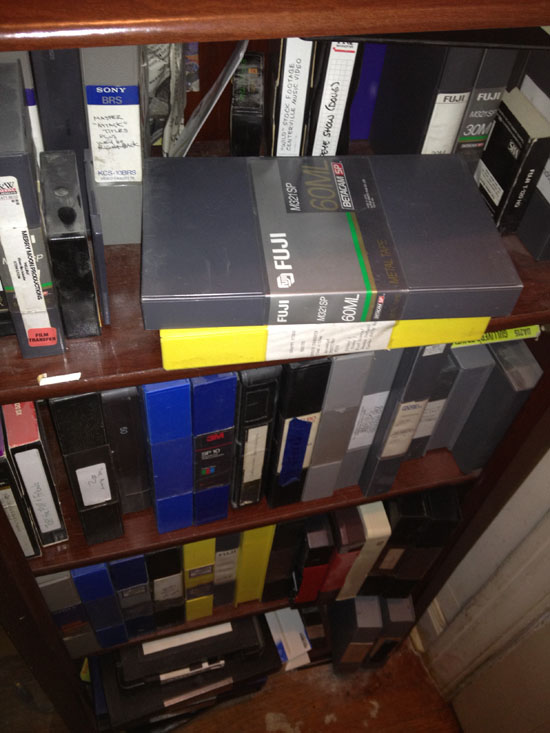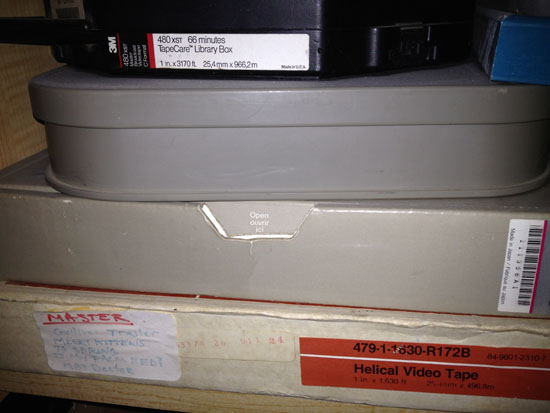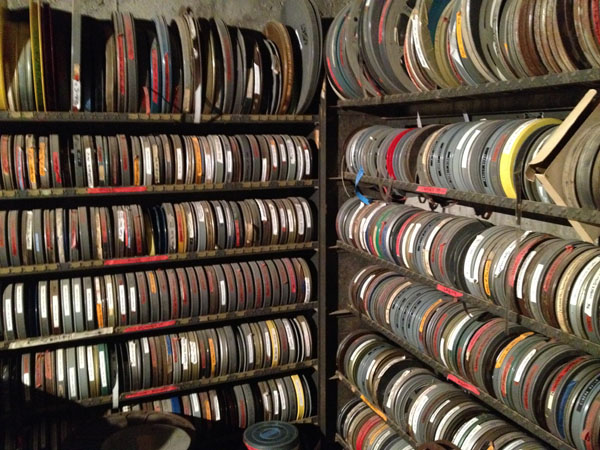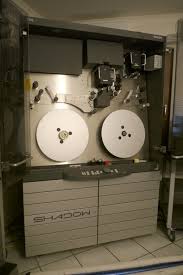 It’s a busy week here – student reviews and a auditorium full of animation history papers to read and grade; I always enjoy the work we’re seeing, though it leaves me with little time for anything else. That said, I thought I’d write a little about the process of putting together one of the Thunderbean DVD releases.
It’s a busy week here – student reviews and a auditorium full of animation history papers to read and grade; I always enjoy the work we’re seeing, though it leaves me with little time for anything else. That said, I thought I’d write a little about the process of putting together one of the Thunderbean DVD releases.
This post is a little tech-ish, but sort of low tech-ish generally- I’ll try to keep the tech talk to the basics!
When Snappy Video started in the late 80s, it made the most sense to use 3/4″ broadcast tape to make a master from the film, then do an edit onto another 3/4″ tape for the final. Then those were dubbed onto VHS tapes (I had a slew of old VHS machines that were the ‘dubbing’ station. I used to have shelves of 3/4″ masters, but these days they’re down to a mere bunch… and a few renegade 1″ masters too. We did most of our transfers at a studio called Filmcraft in Detroit. They had a Rank Cintel Scanner- I had heard this was the best way to do a film transfer, but man it was expensive! I remember spending most of what I made working 2 minimum wage jobs plus my job at the University of Michigan’s film and video library to do transfers back then….for a teenager who just graduated from high school this seemed like a fortune. I think ti was $150 an hour. How many hours is that working at $3.35 an hour?


Funny enough, when the dollar DVD craze happened about a decade ago, some of the stock footage companies that sold public domain material copied full Snappy Video VHS tapes lock, stock and barrel and sold them to dollar DVD companies. I guess our VHS tapes looked better than most pd stuff out there, even though those collections were 15 years old or more…
I found a few of the old Snappy Videos here, on VHS Collector.com.
I’ve managed to transfer most of those old masters to DVCPro, a ‘newer’ standard definition digital format that seems to hold up pretty well, as well as backing those tapes up on a hard drive. Many of the films I’ve found in better quality since then, or have done a new transfer with the newer Telecine machines.

Some of the transfers are done from my own film library, but many of them are borrowed from collectors and archives around the world. There’s nothing better than finding a great print of one of the films for a collection… and many of those great prints have scattered around the world!

In the old days when a transfer was made, it went to a tape format that was compatible with NTSC broadcast standards. This meant that the actual transfer was 29.97 frames per second. Since film runs at 24 frames per second, this means
that every fourth frame has to be held. In reality, it works with the 60 fields per second of NTSC. In mastering a standard def transfer to DVD, it’s possible to make the film run it’s native 24 frames per second (or really 23.98). DVDs didn’t worry about following the NTSC standard frame rate at all.

 If you’re making your own DVDs from telecine transfers, there is software ( I recommend a shareware for Mac called ‘Jes Deinterlacer‘ that reverses the 2/3 pulldown, making a quicktime version without video fields that runs 24 frames per second again without losing quality- nifty! This even works with VHS tapes that have been transferred digitally, as long as the telecine captured the fields correctly. This doesn’t work with the older type of Telecines that made a transfer using a 5 blade shutter-type projector. Those blurred every 4th frame or so, combining images.
If you’re making your own DVDs from telecine transfers, there is software ( I recommend a shareware for Mac called ‘Jes Deinterlacer‘ that reverses the 2/3 pulldown, making a quicktime version without video fields that runs 24 frames per second again without losing quality- nifty! This even works with VHS tapes that have been transferred digitally, as long as the telecine captured the fields correctly. This doesn’t work with the older type of Telecines that made a transfer using a 5 blade shutter-type projector. Those blurred every 4th frame or so, combining images.
For the newer HD transfers, they’re copied directly to a hard drive from the Telecine (then onto my own hard drive from there). We use a Shadow HD Telecine in Oak Park, Michigan, near Detroit. It looks like this (photo at right).
The Shadow is what is called a ‘Line Array’ scanner. The images float along the film gate without stopping, supported and aligned by looking at the sprocket holes on the film rather than a claw lining the film up frame by frame on a
projector. This is especially helpful when dealing with old and shrunken film.
Ok- enuff of that tech-y stuff! More next week…
THIS WEEK’S BONUS CARTOON: Here is Toby in the Museum, an Mintz Studio “Toby the Pup” cartoon released by RKO in 1930. For many years this was the only Toby the Pup available, and incomplete at that. This is one of the films from the old Snappy Video tapes that showed up on Dollar DVDs – complete with the simple title card Mary and I made way back then. Enjoy!


 Steve Stanchfield is an animator, educator and film archivist. He runs Thunderbean Animation, an animation studio in Ann Arbor, Michigan and has compiled over a dozen archival animation DVD collections devoted to such subjects at Private Snafu, The Little King and the infamous Cubby Bear. Steve is also a professor at the College for Creative Studies in Detroit.
Steve Stanchfield is an animator, educator and film archivist. He runs Thunderbean Animation, an animation studio in Ann Arbor, Michigan and has compiled over a dozen archival animation DVD collections devoted to such subjects at Private Snafu, The Little King and the infamous Cubby Bear. Steve is also a professor at the College for Creative Studies in Detroit.






















So, It was YOU who made that title card, huh Steve.
Looking forward to buying Technicolor Dreams and Black and White Nightmares once it’s released. Sorry I didn’t know about the Pre order offer, or I would have gladly pre ordered. BTW: Loved The Gullivers Travel’s release (linked to it on my Facebook). Keep up the GREAT work.
We did most of our transfers at a studio called Filmcraft in Detroit. They had a Rank Cintel Scanner- I had heard this was the best way to do a film transfer, but man it was expensive! I remember spending most of what I made working 2 minimum wage jobs plus my job at the University of Michigan’s film and video library to do transfers back then….for a teenager who just graduated from high school this seemed like a fortune. I think ti was $150 an hour. How many hours is that working at $3.35 an hour?
Now I wonder how I ever got into film collecting in the first place.
This doesn’t work with the older type of Telecines that made a transfer using a 5 blade shutter-type projector. Those blurred every 4th frame or so, combining images.
Meaning the wasted efforts I did one hot summer on the kitchen table with some prints from the public library was in vain, yet I did managed to borrow some great material I can’t get anymore.
Thanks for your message. It probably wouldn’t have been that easy except that by then their film chain was rarely used. KBJR was the last station in the area that even had a working film chain; video cameras had long replaced 16mm for news gathering, and commercials and syndicated shows were either satellite-fed or on tape. Steve might remember better than I do, but as I recall, the production charges were almost unbelievably low; something like $50 an hour and “bring your own blank tape.” (The transfers were to 3/4″ Sony U-Matic cartridges.) A couple of the cartoons I remember transferring there were Ted Eshbaugh’s “Cap’n Cub” and “The Snowman” (B/W Official Films prints) and Hugh Harman’s “Winky the Watchman.”
I, too, was unaware of the pre-order for TECHNICOLOR DREAMS AND BLACK AND WHITE NIGHTMARES. I remember reading articles on it on this site, but I don’t recall noting a pre-order for the set. Are you still taking those pre-orders? I’d gladly support the effort.
Memories, memories…I still remember supervising a couple transfer sessions for Steve at the KBJR-TV studios in downtown Duluth, Minnesota…and hauling shipping cases of film and shopping bagfuls of blank video tape over there on a crowded bus! The transfers that were done there on an old RCA film chain looked pretty good by 1990 standards, but awfully cheezy now. The film chain and everything else there was destroyed by a fire that burned out their entire studios in December 1997. KBJR now operates from new all-digital studios, and most of the people there wouldn’t know a reel of 16mm film if you clobbered them over the head with one. Bill Ward, who directed those sessions, is still there though; just saw Bill last Friday. Bill’s brother-in-law is Dave Kirwan, whose son Alex Kirwan is a pretty formidable talent in TV animation. All terrific folks as well, I’m pleased to say.
Thanks for that anecdote Jeff, didn’t think it was that easy to get a TV station to transfer these prints. Had I known better I would’ve asked around town for the same deal, these days nobody would know that at all I’m sure.